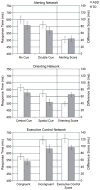Attentional networks in children and adolescents with autism spectrum disorder
- PMID: 20456535
- PMCID: PMC3145814
- DOI: 10.1111/j.1469-7610.2010.02257.x
Attentional networks in children and adolescents with autism spectrum disorder
Abstract
Background: Individuals diagnosed with autism spectrum disorder (ASD) exhibit lifelong abnormalities in the adaptive allocation of visual attention. The ubiquitous nature of attentional impairments in ASD has led some authors to hypothesize that atypical attentional modulation may be a factor in the development of higher-level sociocommunicative deficits.
Method: Participants were 20 children with ASD and 20 age- and Nonverbal IQ-matched typically developing (TD) children. We used the Attention Network Test (ANT) to investigate the efficiency and independence of three discrete attentional networks: alerting, orienting, and executive control. Additionally, we sought to investigate the relationship between each attentional network and measures of sociocommunicative symptom severity in children with ASD.
Results: Results indicate that the orienting, but not alerting or executive control, networks may be impaired in children with ASD. In contrast to TD children, correlational analyses suggest that the alerting and executive control networks may not function as independently in children with ASD. Additionally, an association was found between the alerting network and social impairment and between the executive control network and IQ in children with ASD.
Conclusions: The results provide further evidence of an impairment in the visuospatial orienting network in ASD and suggest that there may be greater interdependence of alerting and executive control networks in ASD. Furthermore, decreased ability to efficiently modulate levels of alertness was related to increased sociocommunicative deficits, suggesting that domain-general attentional function may be associated with ASD symptomatology.
© 2010 The Authors. Journal of Child Psychology and Psychiatry © 2010 Association for Child and Adolescent Mental Health.
Conflict of interest statement
Conflict of interest statement: No conflicts declared.
Figures



Similar articles
-
Attentional Networks in Boys With ADHD or Autism Spectrum Disorder and the Relationship With Effortful Control.J Atten Disord. 2017 Feb;21(3):228-239. doi: 10.1177/1087054712473183. Epub 2016 Jul 28. J Atten Disord. 2017. PMID: 23382577
-
Atypical attentional networks and the emergence of autism.Neurosci Biobehav Rev. 2013 Feb;37(2):164-83. doi: 10.1016/j.neubiorev.2012.11.014. Epub 2012 Dec 1. Neurosci Biobehav Rev. 2013. PMID: 23206665 Free PMC article. Review.
-
Selective Attentional Networks Deficits in Parents of Children With Autism Spectrum Disorder: Evidence From Attention Network Test.Psychiatry Investig. 2023 Aug;20(8):721-729. doi: 10.30773/pi.2022.0248. Epub 2023 Aug 11. Psychiatry Investig. 2023. PMID: 37559453 Free PMC article.
-
Efficiency of attentional processes in attention network theory and autistic symptoms in adolescents with autism spectrum disorder.Front Psychiatry. 2022 Oct 12;13:950245. doi: 10.3389/fpsyt.2022.950245. eCollection 2022. Front Psychiatry. 2022. PMID: 36311533 Free PMC article.
-
The locus coeruleus-norepinephrine system as pacemaker of attention - a developmental mechanism of derailed attentional function in autism spectrum disorder.Eur J Neurosci. 2018 Jan;47(2):115-125. doi: 10.1111/ejn.13795. Epub 2018 Jan 10. Eur J Neurosci. 2018. PMID: 29247487 Review.
Cited by
-
Attention Performance Measured by Attention Network Test Is Correlated with Global and Regional Efficiency of Structural Brain Networks.Front Behav Neurosci. 2016 Oct 10;10:194. doi: 10.3389/fnbeh.2016.00194. eCollection 2016. Front Behav Neurosci. 2016. PMID: 27777556 Free PMC article.
-
Time perception and autistic spectrum condition: A systematic review.Autism Res. 2019 Oct;12(10):1440-1462. doi: 10.1002/aur.2170. Epub 2019 Jul 23. Autism Res. 2019. PMID: 31336032 Free PMC article.
-
Attentional Networks in Adolescents with High-functioning Autism: An fMRI Investigation.Open Neuroimag J. 2016 Sep 30;10:102-110. doi: 10.2174/1874440001610010102. eCollection 2016. Open Neuroimag J. 2016. PMID: 27843514 Free PMC article.
-
Parsing the heterogeneity of brain structure and function in male children with autism spectrum disorder: a multimodal MRI study.Brain Imaging Behav. 2025 Apr;19(2):407-420. doi: 10.1007/s11682-025-00978-y. Epub 2025 Feb 18. Brain Imaging Behav. 2025. PMID: 39966244
-
A Nexus Model of Restricted Interests in Autism Spectrum Disorder.Front Hum Neurosci. 2020 Jun 3;14:212. doi: 10.3389/fnhum.2020.00212. eCollection 2020. Front Hum Neurosci. 2020. PMID: 32581753 Free PMC article.
References
-
- Allen G, Courchesne E. Attention function and dysfunction in autism. Frontiers in Bioscience. 2001;6:D105– 119. - PubMed
-
- American Psychiatric Association (APA) Diagnostic and statistical manual of mental disorders: Text revision DSM-IV-TR. 4. Washington, DC: American Psychiatric Association; 2000.
-
- Belmonte MK, Yurgelun-Todd DA. Functional anatomy of impaired selective attention and compensatory processing in autism. Brain Research. 2003;17:651–664. - PubMed
-
- Burack JA, Enns JT, Stauder JEA, Mottron L, Randolph B. Attention and autism: Behavioral and electrophysiological evidence. In: Cohen DJ, Volkmar FR, editors. Handbook of autism and pervasive developmental disorders. 2. New York: John Wiley & Sons; 1997. pp. 226–247.
Publication types
MeSH terms
Grants and funding
LinkOut - more resources
Full Text Sources
Other Literature Sources

